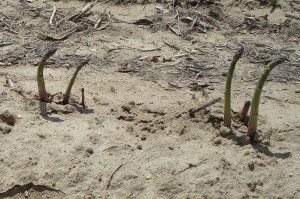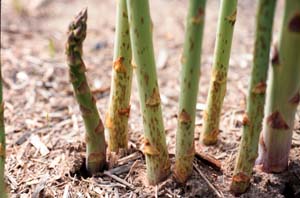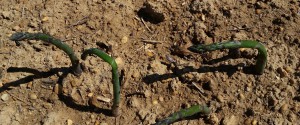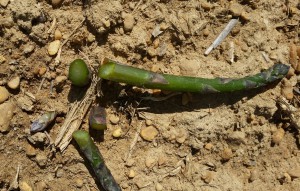Asparagus growers should consider scouting their fields regularly during the summer months for foliar disease development. Important pathogens that growers need to scout for on a regular basis include Purple spot, Cercospora, and Rust. [Read more…]
Preparing for important fungal diseases in Asparagus during the summer.
Asparagus growers should consider scouting their fields regularly during the summer months for foliar disease development. Important pathogens that growers need to scout for on a regular basis include Purple spot, Cercospora, and Rust. [Read more…]
Diagnosing Spear Damage in Asparagus
Spear damage in asparagus can be caused by diseases such as Phytophthora spear and crown rot and purple spot. However, other environmental factors during the spring can damage spears as they emerge from the soil.
| Freeze Injury – About 10 days ago temperatures dipped well below freezing for a night or two, and combined with the higher than normal temperature this spring, some asparagus fields that had already started to produce spears were hit with injury. Affected spears will be bent/distorted and begin to breakdown and rot (Fig. 1a).
Cutting frozen spears will show the discoloration of the spear caused by the freeze (Fig. 1b). |
 Fig. 2. Wind damage of asparagus spears. Notice how all spears are pointed in the same direction |
Wind – Periods of heavy winds during emergence will cause spears to bend. High winds can cause one side of the spear to dry out quicker than the other causing the spear to bend and point in the direction of the prevailing wind. An asparagus planting is suffering from wind damage if most of the bent spear heads in the bed are pointing in the same direction (Fig.2). |
Controlling Purple Spot on Asparagus Spears
Purple spot, caused the soil-borne fungus, Stemphylium vesicarium, can cause problems in cool, wet springs. Symptoms, just like its name, include numerous, sunken oval-shaped spots on spears during the harvest season and more importantly on ferns and stalks during the summer months as long as conditions are ideal for its development.
Twelve hours of wetness is needed for infection and the disease is exacerbated by wind-blown sand injury. Heavy purple spot infection during the summer will lead to premature defoliation which will decrease carbohydrate reserves for the next production season. With the season we had last year and the wet spring we’ve had thus far this year season, pressure due to purple spot may be high. Control of purple spot can be difficult because of management issues (i.e., the mowing and chopping up and leaving of old fern material in the field) and because fungicides can’t be applied during the harvest season. Growers who had pre-mature defoliation issues last year may expect problems this spring. Remember, controlling purple spot begins with preventative fungicide applications during summer and fall by reducing infections to ferns and stalks. Weekly scouting should be done in the spring and followed up with additional scouting and timely fungicide applications once fern stalks are full size. Apply and rotate azoxystrobin (FRAC group 11) at 6.2 to 15.5 fl oz 2.08F/A with chlorothalonil at 2.0 to 4.0 pt/A.
next production season. With the season we had last year and the wet spring we’ve had thus far this year season, pressure due to purple spot may be high. Control of purple spot can be difficult because of management issues (i.e., the mowing and chopping up and leaving of old fern material in the field) and because fungicides can’t be applied during the harvest season. Growers who had pre-mature defoliation issues last year may expect problems this spring. Remember, controlling purple spot begins with preventative fungicide applications during summer and fall by reducing infections to ferns and stalks. Weekly scouting should be done in the spring and followed up with additional scouting and timely fungicide applications once fern stalks are full size. Apply and rotate azoxystrobin (FRAC group 11) at 6.2 to 15.5 fl oz 2.08F/A with chlorothalonil at 2.0 to 4.0 pt/A.
(Photo by M. Hausbeck, Michigan State University)
Preparing for important fungal diseases in Asparagus during the summer.
Asparagus growers should consider scouting their fields regularly during the summer months for foliar disease development. Important pathogens that growers need to scout for on a regular basis include Purple spot, Cercospora, and Rust. [Read more…]
Preparing for important fungal diseases in Asparagus during the summer.
Asparagus growers should consider scouting their fields during the summer months for foliar disease development. Important pathogens that growers need to scout for on a regular basis include Purple spot, Cercospora, and Rust. [Read more…]


